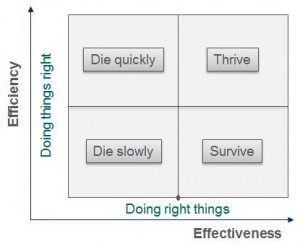The sign of our time is the amazing speed with which changes in the business world happen. This requires from the enterprises of today, and even more of the future to become agile, e.g. capable of adjusting themselves to changes in the surrounding world.
Agility requires focus being moved from optimization to collaboration and creativity. At the same time, current process thinking is continuing to be preoccupied with the issue of optimizing performance through standardization, specialization, and automation. A focus on optimization has resulted in the workflow view (in which a process is considered as a flow of operations) emerging as predominant in the field of Business Process Management (BPM). Besides requiring a long time to develop, predefined sequence of events in a workflow can reduce the creativity of people participating in the process and thereby result in poor effectiveness (doing the right thing) while formally achieving higher efficiency (doing things right). According to the modern organizational science such combination of effectiveness/efficiency might lead to the “die quickly” result:
 Moving focus to collaboration and creativity requires a paradigm shift in BPM that is already happening in practice. This, for example, can be seen in appearing a strong practical movement called Adaptive Case Management (ACM) which “.. is information technology that exposes structured and unstructured business information (business data and content) and allows structured (business) and unstructured (social) organizations to execute work (routine and emergent processes) in a secure but transparent manner.” (http://www.xpdl.org/nugen/p/adaptive-case-management/public.htm)
Moving focus to collaboration and creativity requires a paradigm shift in BPM that is already happening in practice. This, for example, can be seen in appearing a strong practical movement called Adaptive Case Management (ACM) which “.. is information technology that exposes structured and unstructured business information (business data and content) and allows structured (business) and unstructured (social) organizations to execute work (routine and emergent processes) in a secure but transparent manner.” (http://www.xpdl.org/nugen/p/adaptive-case-management/public.htm)